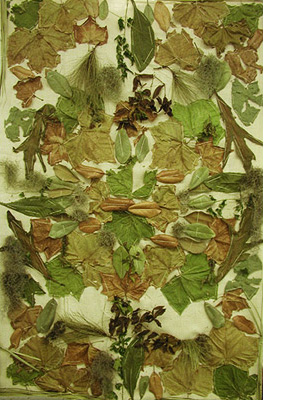Making Art from Nature
Making art from nature involves utilizing various elements of nature (such as leaves, sticks, stones, bones, water, etc) in a creative way to make a new art object. The resulting artwork makes a statement about both nature and humanity's relationship to nature.
This was the way we originally made art. Using natural materials to create art harkens back to the Stone Age, when Prehistoric people would use organic and mineral based pigments, such as metal oxides and iron, to make marks on cave walls.
Fast forward several thousand years, and now these pigments are commercially available in tubes, jars and bottles. Most contemporary artists are far removed from the process of actually making their own paint. The same can be said for paintbrushes, whose main elements were initially natural - hairs from horses, camels, pigs and squirrel to form the bristles, and wood to form the handle. These days many paintbrushes contain synthetic hairs and plastic handles.
Today's art supplies are a combination of natural and synthetic materials. Making art from nature takes a giant leap over this extra step of manufactured art supplies, and returns to the essence of the earth itself as a material for art-making.
Here's an example of art that begins to bridge the gap by incorporating a combination of natural and manmade materials: My Leaf Quilt, above, was created by hand-sewing a variety of leaves onto burlap. I arranged them in a symmetrical form, like a mandala. This was an ephemeral work of art that fell apart over time as the leaves dried up, turned brown, and crumbled from the burlap. This piece was never intended to be used as an actual quilt; rather it was an exploration in the use of unconventional natural materials to make a work of art that would change over time.
Here are a few noteworthy contemporary artists who use natural, unconventional materials to make a statement about nature in art:
Andy Goldsworthy is an artist who uses natural materials such as leaves and stones to create site-specific sculptures that reflect a relationship between the materials and their surroundings. His work is often time-consuming and pain-staking, but it is usually not meant to last. Once completed, his works are photographed and then left exposed to the elements of weather and time. In this way, the actual artwork is ephemeral.
Damien Hirst is a British artist who explores the theme of death in his work. His most famous works involve a series of dead animals (such as a shark, a sheep and a cow) preserved in formaldehyde. One of his works, A Thousand Years, contains an entire life cycle. In this work, maggots feed on the severed head of a cow, turn into flies, and die. New maggots are born, continuing the cycle.
Günther von Hagens is a German anatomist who displays human bodies that have been 'plasticised'. Although he considers himself more of a scientist and medical professional, rather than an artist, he admittedly arranges the bodies in an aesthetic way. Like Hirst, his work is somewhat controversial in terms of whether or not it is truly "art".
Art can challenge viewpoints or attitudes that we didn't even know we had. The work of Hirst and von Hagens is oftentimes seen as controversial for their use of organisms that were once living. These practices raise ethical issues about what is right or wrong in terms of the treatment of deceased organisms, a debate which also hinges around purpose or intention. For instance, it is generally accepted that dissections and autopsies are beneficial for the sake of science and scientific advancement. Taxidermy is also a generally accepted practice in our society. But is it fine art? The act of displaying dead animals for aesthetic purposes, or displaying deceased human bodies for educational purposes, still evokes a wide range of responses. The topic stirs up a wider ring of emotions connected to our inner beliefs regarding life and death, right and wrong.
There is no right or wrong answer - only opinions. If such artwork provokes you into examining your own views of life, mortality, and nature, then perhaps it has served a constructive purpose indeed!
Making art from nature reinterprets the natural elements to prove a point, by reassigning meaning to natural objects. Art from nature is either a new art object in itself, or its essence is recorded in photographic or video form and the real thing is left to disintegrate naturally. Art from nature unites natural elements with artistic vision to create artwork that pushes the boundaries of what art is and how we perceive ourselves in the natural world.







